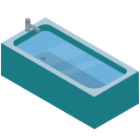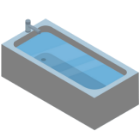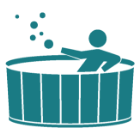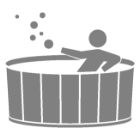Guide To Commrcial Spa / Hot Tub Selection
(by HydroTher)
The purpose of this guide is to assist dealers, designers, architects, mechanical contractors and commercial facility owners or operators better understand the basics in regulations, practicalities and maintenance regarding commercial spas and hot tubs so that they may be better educated on how to chose the correct model for their particular needs.
THE DIFFERENCE BETWEEN SPAS, HOT TUBS, WHIRLPOOLS AND JACUZZI’S
A whirlpool is a bathtub equipped with hydrotherapy jets. Hot tubs or “Spas” as they were commonly referred to until the last few years encompassed all the other types whether portable or in ground, residential or commercial, above-ground, in-ground or made from wood, fiberglass, stainless steel, vinyl or concrete.
Jacuzzi is a manufacturer of both whirlpool bathtubs for the bathroom as well as residential hot tubs.
There are many North American manufacturers of whirlpool bathtubs and almost a hundred manufacturers of residential hot tubs. At the time of writing this guide there are only a handful of commercial hot tub manufacturers.
Originally all types were called whirlpools. These units were made of concrete, and either painted or tiled. The first installations were in the 60’s in health clubs, hotels and in a few select homes.
Unfortunately these early concrete versions were very expensive due to the custom labor and bulky materials, so mass popularity was limited.
In the mid 70’s, some entrepreneurial “hippies” in California started converting old discarded wooden wine barrels into above ground, almost portable whirlpools, and the term “hot tubs” was born.
While these wooden “hot tubs” were more affordable, they quite often leaked for the first couple of days after installation while the tub “swelled”. This initial leaking combined with the necessity of “at–the–site” plumbing made these initial versions expensive. Furthermore, the porous wood made proper water sanitation and chemical balancing difficult, and the dark wooden round or oval shapes limited marketability. These negatives led to the introduction of gel coated, fiberglass reinforced models.
These fiberglass units were promoted as “spas” by the pool industry to eliminate any association with the wooden hot tubs.
Unfortunately, within a few short years, Gel Coat fiberglass spas proved to be unable to stand up to hot, chlorinated water 24 hours a day, 365 days a year. The cobalt promoter in the fiberglass “leached “ to the surface resulting in black spots, or as it is referred to within the industry, “black plague”. While there are a few manufacturers successfully manufacturing gel coat hot tubs today using new improved products, the introduction of spas made from vacuum formed, continuous cast acrylic sheet, reinforced with fiberglass in the early 80’s, proved to be the answer to providing an inexpensive yet durable and aesthetic pleasing way to manufacture spas, hot tubs and whirlpools (whatever you would like to call them) and is still the accepted norm today.
The acrylic sheet prevents water from penetrating to the fiberglass layer and provides a surface that is durable and available in a wide assortment of colors.
Vibrant colors and a wide range of size, shape and jet options quickly made the hot tub a necessity in most North American fitness facilities, hotels, spas, condominium /apartment complexes and better homes. The addition of a hot tub has proven to increase the sales appeal of condos, hotels and fitness facilities.
While there are hundreds of manufacturers in North Americas manufacturing home hot tubs, only a handful manufacture commercial units designed to meet Provincial or State regulations such as riser heights on the stairs, dual suction ports, color coding of drop offs and stair edges, filter turnover ratios, etc.
In recent years most acrylic spa manufacturers came to the realization that the public most commonly refers to the home units as “hot tubs” or even as Jacuzzi’s, regardless of whether they are made from concrete, wood or acrylic, or whether or not they are actually made by the manufacturer Jacuzzi. Furthermore the word “spa” became more associated with business’s that offered massages, facials, etc. As a result the use of the word “spa” is almost a thing of the past with almost all manufacturers now referring to their products as” hot tubs”.
THE DIFFERENCE BETWEEN RESIDENTIAL AND COMMERCIAL MODELS
Commercial models are designed for Health Clubs, Hotels, Apartments/ Condominiums or Recreation Centre’s. Health and building codes do not allow conventional home hot tubs to be installed in these types of commercial facilities.
Conventional residential hot tubs that are sold for home or backyard use are not equipped with the right equipment to meet Commercial codes in most Provinces or States. Furthermore, the shell designs of residential hot tubs do not generally meet the required codes for Commercial installations and often do not have proper access steps or are equipped with lay-down loungers which can impede safe movement within the spa.
Commercial units are generally larger. They have a separate pump to circulate the water through the filter and the heater and a separate pump or multiple pumps to drive the jets. They are available in many voltages, both single and three phase. Commercial units must have steps that conform to building codes in regards to riser heights and surface area. The edges of the stairs and seats must be color coded. The surface skimmer and all fittings must be NSF approved and the water turnover circulation rates must meet specified guidelines.
In most States and Provinces the unit must be equipped with an automated chemical sensing and dosing controller as well as anti-entrapment devices, automatic water level controllers, etc. Each unit must have either two separate drains spaced at least 3’ apart or have two drains on different vertical plains.
Common types of commercial hot tub shells include concrete, stainless steel, fiberglass and acrylic.
Below we have listed some of the pros and cons of each type.
CONCRETE
Pros:
- No limitations in shape and design
- Can be built to identically match adjacent pool
- Life expectancy before major shell work required…15-20 yrs Cons:
- Very expensive
- Very messy construction
- Very heavy…may require special support structure, especially on upper level.
- Not flexible…can crack if drained or refilled too quickly
- Not overly comfortable due to difficulty in building “lumbar” support into the forms
- Will require additional waterproofing of the membrane
- Poor insulating qualities
- Plumbing is generally installed inside the concrete and is difficult to access for repairs
- May require yearly or bi-yearly maintenance such as tile grouting or replacement
STAINLESS STEEL
Pros:
- Surface is readily accepted for hospital installations
- Surface will last a lifetime without needing replacement
- Plumbing is outside of shell and easy to access for repair
- Flexible shell…can be drained and refilled quickly. Cons:
- More expensive than acrylic or fiberglass shells
- Limited sizes and shapes available
- Institutional, cold look and feel
- Poor insulating qualities
- Life expectancy before replacement required…unlimited
GEL COAT FIBERGLASS
Pros:
- Wide assortment of sizes, shapes and colors
- Plumbing is outside of shell and easy to access for repair
- Easy to repair
- Good insulating qualities
- Warm look and feel
- Flexible shell…can be drained and refilled quickly. Cons:
- Slightly more expensive than acrylic / fiberglass units
- Surface will require waxing and buffing several times a year
- Can discolor
- Heavier than fiberglass /acrylic units
- Can crack if severely abused
- Life expectancy before shell replacement required…12- 15 yrs
FIBERGLASS REINFORCED ACRYLIC
Pros:
- Least expensive
- Wide assortment of sizes, shapes and colors
- Very light…can be installed on rooftops or upper levels
- Plumbing is outside of shell and easy to access for repair
- No regular maintenance on shell is required
- Easy to repair
- Good insulating qualities
- Warm look and feel
- Flexible shell…can be drained and refilled quickly.
- Acrylic surface is guaranteed to provide 100% waterproofing.
- Surface will not discolor.Cons:
- Can crack if severely abused
- Life expectancy before shell replacement required…12- 15 yrs
HOW COMMERCIAL HOT TUBS WORK
The circulating single speed pump draws water from the surface skimmer as well as the floor drain/suction fittings. This water is directed through the filter (generally sand but some times cartridge) through the heater (usually electric) and back to the hot tub through two deep heat return fittings that are usually located in the lower foot well section of the spa. This circulation pump generally operates twenty four hours a day but can be installed on a timer.
The jets are driven by a separate jet pump, which draws the water through a minimum of two suction fittings on the lower foot well sidewall and returns the water through the hydrotherapy jets.
The jets are connected via a venturi topside air control nozzles which allow the user or operator to control the mixture of air/water ratio in the jets.
The jet pump is (in most Provinces and States) is required to be connected to a fifteen minute timer mounted at least ten feet from the spa water. It is believed that if the user has to continually exit the spa to reactivate the jets that they will not stay in the spa too long which could lead to drowsiness or fainting.
All plumbing is in flexible or rigid P.V.C pipe and the equipment is designed to be installed up to 15’ of pipe length away.
Water level controllers maintain proper water height to ensure proper circulation, filtration, heating and jet action. A special fitting is installed on the spa that allows water to flow to the leveler. The leveler is connected to a ½” fresh water feed and allows fresh water to flow into the spa should the float on the leveler determine that the water level is low.
Handrails aid in safe entry and exiting from the spa. These handrails are available with a bolt-down mounting flange or with anchors that requires cementing into the deck.
Commercial Hot Tubs should be drained and refilled as per the following schedule:
1/3 of the total gallons in the unit divided by the number of users equals the number of days allowed between draining.
Hot Tubs with sand filters require backwashing several times per week. Backwashing is a process where the direction of water flow is changed so that it comes up through the sand and carries away the dirt. This will obviously result in a significant amount of the spa water being displaced and requiring replacement. This will increase the number of days allowed between draining.
A negative of sand filters is that they do not filter out the very fine particles as well as cartridge filters. Also, the water loss associated with backwashing must be timed properly to minimize downtime for refilling and heating.
Sand filters are also bulkier in size than cartridge filters therefore requiring more mechanical room space.
This is why more and more commercial hot tubs are being equipped with cartridge filters.
With hot tubs with cartridge filters, when flow rates slow, or the filter shows signs of being dirty, the cartridge is simply removed from its canister, sprayed clean with a high pressure hose and re-installed. Once every two or three cleanings, the filter should be soaked overnight in a filter cleaner and once a year replaced entirely. When planning your mechanical room, remember to include an area where the cartridge can be sprayed conveniently.
CHOSING SIZE AND SHAPE
Many residential hot tubs have bucket seats and lay-down loungers, which are not recommended for commercial hot tubs as they restrict seating and could cause users to stumble and fall in the hot tub. As a result, bench style seating is most popular with commercial hot tubs. Models with varied depths of seating better accommodate children or smaller adults. To ensure that the hot tub will be comfortable for a tall adult high it is not the depth of the model, but rather the riser height from the seat to the water level which must be designed properly. Very important is that the model has wide built-in access steps that are designed to minimize slipping. Don’t necessarily oversize the model, smaller models are not only less expensive, they are easier to maintain and more intimate.
CHOOSING THE NUMBER OF JETS, HEATER TYPE, VOLTAGE
Unless the hot tub is being installed for therapeutic reasons, (such as in a clinic or sports therapy centre), one or two jets per seat is sufficient. More jets will not only increase the cost, but increases the maintenance as well as jets do get plugged and more jets require more pumps, or larger capacity pumps.
Pump size should be based on the gallon per minute flow as there is some misleading marketing within the hot tub industry in regards to the size of the pumps. Most residential hot tub pump motors are 48 frame high performance pumps with 2 horsepower motors. Due to the fact that these pumps will often pump more gallons per minute than conventional 3, 4, and even 5 horsepower pool pumps, many hot tub pump manufacturers, as well as most hot tub manufacturers, are now labeling their pumps 4HP, 4.5HP and even 5HP with the HP referring to high performance or hydrotherapy power, not conventional horsepower.
Commercial hot tubs are generally equipped with larger 56 frame true 3 and 5 horsepower pumps.
Conventional residential hot tubs use electric heaters that operate on 120 or 230 volt single phase. They are available in 2, 3 and 4.5 kW sizes. Commercial heaters are always 220v or higher voltages if 3 phase . They are usually sized 11 kw or higher.
Gas heaters and hot water heat exchangers are possible alternatives but it is the opinion of HydroTher that the relatively low initial cost of electric heaters, combined with the way they can be easily integrated into the hot tub control system makes electric heaters the only practical choice.
When specifying equipment always remember to include magnetic starters, contactors, timers and GFCI’s where necessary.
IN-GROUND OR ABOVE GROUND
Your Commercial Hot Tub can be installed in the ground, above the ground or half and half.
Installations where the top lip of the hot tub is located 6 – 8” (15 - 20 cm) off the ground is recommended as the minor step up required will often slow the user down enough to ensure proper footage on the interior steps and prevent falling into the hot tub.
Ensure that the proposed ceiling height will accommodate proper entry/exit from the hot tub.
In situations where the hot tub is an add-on, ensure that the hot tub will fit through your existing door and halls.
In new construction it is important that the hot tub is ordered with sufficient notice to ensure that the unit can be manufactured and delivered to site before interfering walls or doors are erected.
WASHROOM/ SHOWER FACILITIES
In most regions the building department will require that users pass by washroom and shower facilities before entering the hot tub so that they can take a shower using warm soap as is mandatory in most regions.
DECK DRAINS / WATERPROOFING/ FRESH WATER RINSING
It is recommended that sufficient deck drains be installed to accommodate spillovers, deck cleaning, etc.
The close proximity of a garden hose hookup for cleaning purposes is recommended.
The installation of a waterproof membrane on the floor and lower walls under the tile and walls is strongly recommended.
WHERE TO LOCATE THE EQUIPMENT
Whereas residential hot tubs generally have their equipment installed under the hot tub shell itself, the equipment for Commercial models is usually shipped from the factory on a separate skid platform, allowing installation in a separate mechanical room with floor dimensions of at least 6’ x8’. (1.82 m x 2.44 m)
The mechanical room should not be located further than 15’ (4.57 m) of pipe length away from the hot tub. Where mechanical room location is required to be further away, equipment upgrading may be necessary. Mechanical rooms should also be equipped with floor drains as well as fresh water lines to connect direct to the hot tub plumbing.
BROMINATORS / CHLORINATORS
Brominators and Chlorinators allow the operator to adjust the amount of water flow over the proven disinfecting chemical of choice, Bromine or Chlorine, thus slowing or increasing the disbursement to the desired amount. They also accommodate up to a week’s amount of chlorine or Bromine, thus minimizing staff involvement. The brominator or chlorinator is located in the mechanical room, plumbed in after the pump. The choice between brominator and chlorinator is up to the operator, however, in our opinion, bromine tends to be regarded as a more effective sanitizer in hot water than chlorine.
SALT GENERATORS
These machines convert an added salt residual in the water to chlorine, or in some cases bromine via a low voltage current, thereby eliminating the need to purchase chlorine or bromine. Payback is generally two to three years however many owners feel the improved “feel” and “smell” of the water, combined with the elimination of purchasing as much chemical more than justifies the added purchase price. Please note that in most States and Provinces regulations demand the hot tub is still equipped with a backup chlorination or bromine system.
IONIZERS
Ionizers are devices, which also improve water clarity and reduce chemical consumption.
While many residential pool and spa owners are emphatic over the positive impact that these units have had on their pools and spas, HydroTher is not aggressively promoting ionizers at the time of writing this guide. Our concern is that they have no disinfecting ability yet many of the pool and spa owners that have these units believe that it is an adequate substitute. In simple terms, ionizers give the same results as regularly using an algaecide as a supplement to chlorine or bromine.
WATER CHEMISTRY CONTROLLERS
These devices have sensing probes that determine the ORP (Oxidation Reduction Potential) of the water as well as the pH. When the probes sense the need for chemical the controller allows either the chlorinator to start or the solenoid valve on the brominator to open allowing water to flow into the brominator to dissolve bromine which will flow to the hot tub. When the proper readings are achieved the controller turns off the chlorinator or brominator.
AUTOMATIC WATER LEVEL CONTROLLERS
Every time a user leaves the hot tub, they take some of the hot tub’s water with
them.
Furthermore, when several people sit in the hot tub at once, the water can rise
over the edge.
In both these instances this results in the water being too low. Automatic water
level controllers are units that are mounted on the wall of the mechanical room
or in the deck at the desired height of the hot tub water. A fresh water line is
connected to the controller. When the water level drops, a leveling valve in the
controller activates the fresh water until it reaches the set level.
SAFETY ACCESS HANDRAILS
To minimize the chance of someone slipping when they enter or exit the hot tub
the installation of these stainless steel rails is advised.
FLOATING INSULATING COVERS
These light covers are placed on the hot tub at night or whenever the hot tub is
not in use, to reduce heating costs and minimize evaporation.
SAFETY HARDCOVERS
These covers achieve the same insulation and heat retention benefits of floating
covers but also prevent children from obtaining access to the spa / hot tub.
SAFETY SIGNS / SAFETY DISCONNECT / FIRST AID BOX / EMERGENCY
PHONE
Each commercial hot tub installation should include a rules and safety procedure
sign, an emergency power and pump disconnect, first aid box and emergency
phone in close proximity. Please consult with your local authorities for specifics in
your area. Operators should appoint staff to regularly check the hot tub while in
operation to ensure that it is being used safely and that the chemical balances
are correct.
One Piece Acrylic Hot Tubs
Why are HydroTher Acrylic Hot Tubs my best choice?
A commercial hot tub shell is asked over it’s operational life to tolerate hundreds of cycles of hot water being drained and then being refilled with a relatively cold water. These cycles of loading and thermal stress can generate flexing of the spa shell. This flexing can exceed the capability of concrete and concrete waterproofing systems, causing the concrete shells and/or the piping and fittings encased within them to leak. The repair of a leaking concrete shell can be very expensive, up to and including the demolition of the shell and reconstruction.
HydroTher acrylic hot tub shells on the other hand, avoid this costly scenario by allowing the shell to flex and accommodate these stresses. Piping remains accessible for any service or fitting replacement. HydroTher shells do not rely on waterproof membranes as concrete spas do and our acrylic spa shells remain resistant to normal water chemistry conditions unlike concrete and most waterproofing materials.
Because our hot tubs are prefabricated, project cost remains low and timelines for construction are more easily met. Our preplumbed mechanical support systems are perfectly matched to our shells for optimal performance.
HydroTher Spas are much lighter than concrete spas. Our entire range of spas are all below 100 lbs. (46 kg.)/ sq. Ft. (.093 m2) providing much greater flexibility in choice hot tub location.
Highest value
Five models to choose from [ H-600C | H-800C | H-1000C | H-1100C | H1200C ]
Lowest weight option
Greatest piping access
Low Maintenance
Waterproof surface
Efficient operation
Wide range of options
Waterline tile available
Shell is replaceable
Full mechanical packages available












